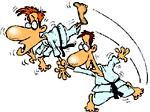





Q- Why do we need to wear a special suit?
A- You don’t really have to. Karate can be
practiced in a track suit or other ordinary clothes, but the wearing of
a white cotton Gi as it is called, is traditional, and gives one a sense
of identity and is very functional.


Q- Why are there different colour belts?
A- A colour system belt is used to denote
the skill-level of the wearer.

Q- How many times a week should I practise?
A- As often as you are able but at least
twice a week.

Q- I suffer from Asthma, should I still
practice?
A- Oh yes, most certainly! In fact, as long
as you make sure that who ever is taking class knows that you suffer from
Asthma, and as long as you are sensible and rest when you feel an attack
coming on, then your training will do you good. Many types of physical
disability in young students can be helped by karate training, however
it is important that you inform your instructor of any problems

Q- Is there anything to look for to show
whether the club I want to join is a good or a bad one?
A- That is a good question? First, ask your
parents to try and find out about the instructor: What are his/her
qualifications? What do other members of his/her class think? Do they enjoy
the classes? Does he/she seem to be “into” his/her classes or does he/she
merely stand in front issuing directions?

Q- Instructor, why do we call you “Senpai”
(Sensei)?
A- It simply means “teacher” in Japanese
and it is a sign of respect.
Q- What does Karate mean?
A- Simply translated it means “empty hand”.
Karate is a method of training the human body for fighting and self defence
purposes.

Q- Why do we bow as we enter the practice
hall and when we meet another teacher or student?
A- The bow, or REI in Japanese is a sign
of respectful greeting, much as the handshake in the West.
![]()
Q- What is Ashihara and how does it differ?
A- Ashihara is a school of Karate named after its
chief instructor, Hideyuki Ashihara. Initially his school was referred
to as Ashihara’s Karate school, but after a while people started
calling it Ashihara Karate. This system differs from other styles in that
it is taught with pleasant vestiges of traditionalism and a broken down
number of techniques to make the learning go quicker.

 Return
to Home Page
Return
to Home Page